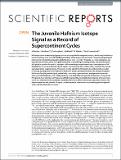The juvenile Hafnium isotope signal as a record of supercontinent cycles
Date
07/12/2016Metadata
Show full item recordAbstract
Hf isotope ratios measured in igneous zircon are controlled by magmatic source, which may be linked to tectonic setting. Over the 200-500 Myr periodicity of the supercontinent cycle - the principal geological phenomenon controlling prevailing global tectonic style - juvenile Hf signals, i.e. most radiogenic, are typically measured in zircon from granites formed in arc settings (crustal growth), and evolved zircon Hf signals in granites formed in continent-collision settings (crustal reworking). Interrogations of Hf datasets for excursions related to Earth events commonly use the median value, however this may be equivocal due to magma mixing. The most juvenile part of the Hf signal is less influenced by crustal in-mixing, and arguably a more sensitive archive of Earth's geodynamic state. We analyze the global Hf dataset for this juvenile signal, statistically correlating supercontinent amalgamation intervals with evolved Hf episodes, and breakup leading to re-assembly with juvenile Hf episodes. The juvenile Hf signal is more sensitive to Pangaea and Rodinia assembly, its amplitude increasing with successive cycles to a maximum with Gondwana assembly which may reflect enhanced subduction-erosion. We demonstrate that the juvenile Hf signal carries important information on prevailing global magmatic style, and thus tectonic processes.
Citation
Gardiner , N J , Kirkland , C L & Van Kranendonk , M J 2016 , ' The juvenile Hafnium isotope signal as a record of supercontinent cycles ' , Scientific Reports , vol. 6 , 38503 . https://doi.org/10.1038/srep38503
Publication
Scientific Reports
Status
Peer reviewed
ISSN
2045-2322Type
Journal article
Description
N.J.G. and C.L.K. acknowledge funding from the Institute for Geoscience Research (TIGeR) at Curtin University. M.V.K. is supported by funds from the ARC Centre of Excellence for Core to Crust Fluid Systems (CCFS).Collections
Items in the St Andrews Research Repository are protected by copyright, with all rights reserved, unless otherwise indicated.

